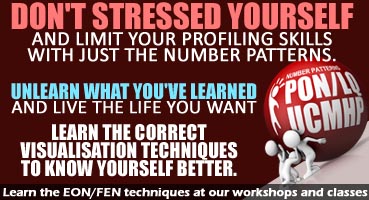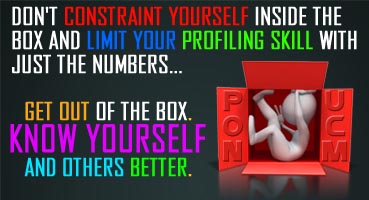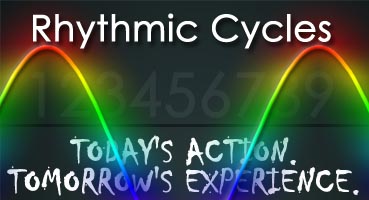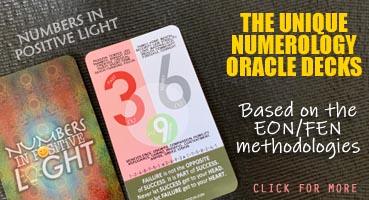Interpreting Mirror Charts
Aileen discovered one of her friends has a mirror chart, after reading my book, “Elements of Numbers: Fast and Easy Character Profiling” and plotting his birth chart. She wondered what else can we gather from a mirror chart. In a subsequent email, she wrote, “what I concluded from the reading is that I saw the number 1-2-3 from both sides, and a lot of 9s. It’s kind of confusing to see this number.”
I have described the basic characteristics in a person with a special chart that we termed as “mirror chart” on Page 69 and Page 203 of my book. You might want to check the page first, if you have a copy of my book, to understand the basic interpretations of the mirror chart. In this article, I’ll also share fresh samples of the ‘beyond the norm’ observations made when profiling the chart using the Elements of Numbers (EON) methods.
 Let’s begin with John’s chart. In a “mirror” chart, the left section (numbers in locations I-J) is a mirror reflection of the right section (reflected numbers in locations K-L). When we see a chart with the numbers 2-1-2-1 in I-J-K-L locations on a person’s birth chart, we gather that as a normal chart. It’s like having four people (boy, girl, boy, girl) standing in a row. However, when we see a 2-1-1-2 pattern in I-J-K-L locations, we’d considered as a “mirror” chart since the 2-1, when reflected upon a normal mirror surface, would be seen as 1-2. Hence, the meaning of a mirror chart when we see sample patterns like 2-1-1-2, 9-1-1-9, 1-1-1-1, 3-1-1-3, and 4-3-4-3.
Let’s begin with John’s chart. In a “mirror” chart, the left section (numbers in locations I-J) is a mirror reflection of the right section (reflected numbers in locations K-L). When we see a chart with the numbers 2-1-2-1 in I-J-K-L locations on a person’s birth chart, we gather that as a normal chart. It’s like having four people (boy, girl, boy, girl) standing in a row. However, when we see a 2-1-1-2 pattern in I-J-K-L locations, we’d considered as a “mirror” chart since the 2-1, when reflected upon a normal mirror surface, would be seen as 1-2. Hence, the meaning of a mirror chart when we see sample patterns like 2-1-1-2, 9-1-1-9, 1-1-1-1, 3-1-1-3, and 4-3-4-3.
From basic keyword interpretations, we could correlate the 2-1-1-2 as [Talk – Alone – Alone – Talk]. It is like a confusing, lonely, self-talking person who wasn’t sure of the directions (left or right) to concentrate on. Using a wilder analogy, it’s like a man torn between two lovers. He prefers staying with the woman to the left, and yet he cannot live without the woman on the right. On the one hand, he gossiped to B about A; and then gossiped to A about B. Through prolonged confusing and indecisive habits, these could manifest the evasive and manipulative traits, in addition to making defensive comments like, “Don’t anyhow tell lies. I didn’t say that!” However, if John isn’t behaving likewise, or showing such signs occasionally, that means he could probably have outgrown his childhood’s confusing mindsets.
 In general, a person with mirror chart tends to have split or dual personalities. He can display characters of soft-talking, patient, and lady-like nature now, and suddenly changed over to the extreme end and gives signs of loud, impatient, and forceful nature minutes later. For mirror charts, we can take account of the duality attributes (the Yin and Yang) to a set of numbers. Take, as an example, the numbers 3-3 in locations M-N of John’s birth chart. A quick keyword interpretation could be [Fast – Fast] implying a snappy, impatient, hurtful, and hasty person who cares more for the end-results than the process. On the other hand, it could also imply a patient, creative, passionate and inspiring, tolerant, and focused person who cares for the experience (exploratory process) than the end-result.
In general, a person with mirror chart tends to have split or dual personalities. He can display characters of soft-talking, patient, and lady-like nature now, and suddenly changed over to the extreme end and gives signs of loud, impatient, and forceful nature minutes later. For mirror charts, we can take account of the duality attributes (the Yin and Yang) to a set of numbers. Take, as an example, the numbers 3-3 in locations M-N of John’s birth chart. A quick keyword interpretation could be [Fast – Fast] implying a snappy, impatient, hurtful, and hasty person who cares more for the end-results than the process. On the other hand, it could also imply a patient, creative, passionate and inspiring, tolerant, and focused person who cares for the experience (exploratory process) than the end-result.
It’s confusing, isn’t it? That’s because we are analysing a mirror chart; and that we should adopt a slightly different approach to analyse the chart. There are other extended techniques that you can apply, like using the Reflection Chart, Periodic Code, and Hidden Pattern methods I’ve shared with past FEN (Five Elements Numerology) students. For instance, I observed tendency signs that suggest John (or anyone with the similar 2-1-1-2 patterns) is also financially-motivated and has a tendency toward maximising his influencing skills to manipulate people’s minds for his benefits. By and large, their subconscious materialistic thoughts and face-conscious behaviours could show some form of EQ communicative problems.
 A good profiler is not about boasting you have analysed 10,000 or more case studies, or proclaiming confidently that certain traits will definitely happen (in the future) when specific number patterns are present in a person’s chart. I have always advised my FEN students to use logical and practical judgement to determine a distinct trait, and if possible, identify the underlying reasons to the person’s behaviours whenever such patterns surface. For example, John has the characteristics of a success-driven and attention-seeker person. However, the multiple 9s in his chart need not necessary produces successful outcomes often. He might face competitive setbacks when he sets his hopes, visions, and goals high, and/or when humility is overshadowed by greed. Taking short cuts to achieve success can be fun, rewarding, and exciting, but it is short-lived. It can be hurtful when fundamentals (moral, social, humility, etiquettes) are pushed aside and foundational principles (knowledge, SME – subject matter experts) are neglected.
A good profiler is not about boasting you have analysed 10,000 or more case studies, or proclaiming confidently that certain traits will definitely happen (in the future) when specific number patterns are present in a person’s chart. I have always advised my FEN students to use logical and practical judgement to determine a distinct trait, and if possible, identify the underlying reasons to the person’s behaviours whenever such patterns surface. For example, John has the characteristics of a success-driven and attention-seeker person. However, the multiple 9s in his chart need not necessary produces successful outcomes often. He might face competitive setbacks when he sets his hopes, visions, and goals high, and/or when humility is overshadowed by greed. Taking short cuts to achieve success can be fun, rewarding, and exciting, but it is short-lived. It can be hurtful when fundamentals (moral, social, humility, etiquettes) are pushed aside and foundational principles (knowledge, SME – subject matter experts) are neglected.
 There are other extended techniques to share with everyone. However, I could only provide some basic methods here, and share the rest to deserving FEN students who recognised my research findings, coaching, and practical applications of the EON method. Anyway, I’m happy if you’re a PON or UCMHP trainer who constantly checks this site for ‘free’ lessons to share with your students. Giving credits would be great. If you have a blog site, I appreciate if you include a direct link back to this EON site (www.ElementsOfNumbers.com) instead of plagiarising my articles. One user gave me a link to a foreign blog site where the blogger translated some of my articles to Bahasa Indonesia language, without due credits. Such ‘copy and paste’ method could do more harm to the blogger eventually, as others could his or her profiling knowledge once readers figured out the articles posted by the blogger were ripped versions. If you’re the blogger whom I’ve mentioned, including a link back to my EON site and giving credits would allow your readers to appreciate your truthful character.
There are other extended techniques to share with everyone. However, I could only provide some basic methods here, and share the rest to deserving FEN students who recognised my research findings, coaching, and practical applications of the EON method. Anyway, I’m happy if you’re a PON or UCMHP trainer who constantly checks this site for ‘free’ lessons to share with your students. Giving credits would be great. If you have a blog site, I appreciate if you include a direct link back to this EON site (www.ElementsOfNumbers.com) instead of plagiarising my articles. One user gave me a link to a foreign blog site where the blogger translated some of my articles to Bahasa Indonesia language, without due credits. Such ‘copy and paste’ method could do more harm to the blogger eventually, as others could his or her profiling knowledge once readers figured out the articles posted by the blogger were ripped versions. If you’re the blogger whom I’ve mentioned, including a link back to my EON site and giving credits would allow your readers to appreciate your truthful character.
Anyway, I’ve always encouraged my FEN students to learn the EON techniques through practical ways and explore their profiling capabilities. Seek and ask questions whenever possible, and clarify them when in doubt. Read my articles, digest, and expanded on them from other perspectives. I’m happy to share more extended techniques with you and others in my class.
Lastly, there’s one essential criteria to kickstart yourself to become a good behavioural and personality profiler, i.e. to inculcate the attentive and curiosity attitudes. If you noticed the list of sample patterns I’ve mentioned earlier are somehow incorrect and confusing, then you have the attributes of becoming an experienced profiler. Why? Oh… in case you aren’t aware – I’d intentionally include the 4-3-4-3 pattern as a mirror chart. And to the attentive readers, a chart with 4-3-4-3 in I-J-K-L is not a mirror chart. However, a chart with 4-3-3-4 in I-J-K-L is said to be a mirror chart.
 One more thing… in a mirror chart, the numbers present on the left side reflects to the right side. That’s correct, many of you’d have agreed, especially those who studied the PON or UCMHP from some external trainers. Some students asked me some years back why PON charts have the location’s S-T displayed with the T nearer to M. I told them the location sequence in PON might be wrong and confusing. When I formulate the EON chart, I referenced the layout to a person doing meditation, with the body parts located correctly (like the shoulders are closer to the body, i.e., location’s S to M, and V to N). In PON chart, the location T is closer to M instead. Anyone with the rational and sensible mindset would have agreed the location of S and T used in EON is more natural when you superimposed a person’s body on the chart.
One more thing… in a mirror chart, the numbers present on the left side reflects to the right side. That’s correct, many of you’d have agreed, especially those who studied the PON or UCMHP from some external trainers. Some students asked me some years back why PON charts have the location’s S-T displayed with the T nearer to M. I told them the location sequence in PON might be wrong and confusing. When I formulate the EON chart, I referenced the layout to a person doing meditation, with the body parts located correctly (like the shoulders are closer to the body, i.e., location’s S to M, and V to N). In PON chart, the location T is closer to M instead. Anyone with the rational and sensible mindset would have agreed the location of S and T used in EON is more natural when you superimposed a person’s body on the chart.
Well, you can plot any sample mirror chart, or look at John’s chart again. The 5-4 (we can visualise them as hand-shoulder) at the left side is a mirror-reflection of the 4-5 (shoulder-hand) at the right side. Briefly, this means seeing something like a 5-4 and 4-5 pattern in EON, or (hand – shoulder – [body] – shoulder – hand) when you look at yourself in the mirror. Unfortunately, I noted a deformed-like 4-5 and 4-5 (shoulder – hand – shoulder – hand) pattern in PON. Perhaps there is a reason for its placement why T is nearer to M in the PON method, and you should seek clarification from your PON, UCMHP, or LifeQuest trainers for a logical explanation. Oh, let me know the reasons. 8:))
I hope Aileen finds insightful information in this article on interpreting ‘mirror’ charts. She must also understand that the patterns 2-1-3 (at the left side, in I-J-M) have different traits or characters associations than the 1-2-3 (at the right side, in K-L-N). Even if John hasn’t exhibited many of the traits mentioned, that’s alright to me as it demonstrates John could have changed and transformed his negative thoughts into beneficial ones. And the positive influencing thoughts could have originated from formative years (family upbringing, moral principles, environment, schooling) and social habits. Or John might display the traits one day, in the future… when the negative energies are manifested strongly.
Regards, Ron WZ Sun















